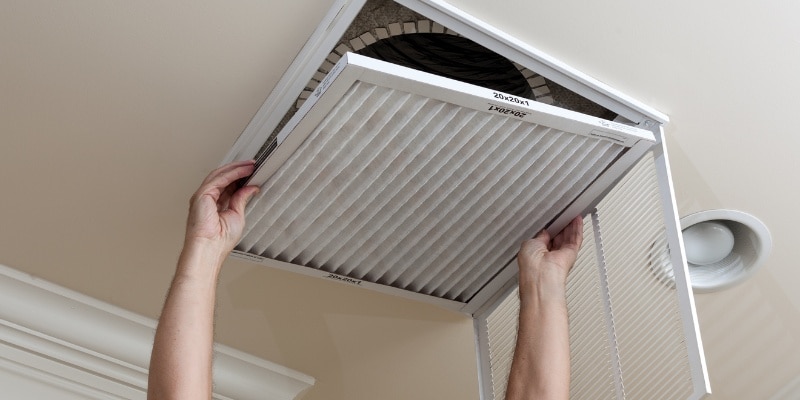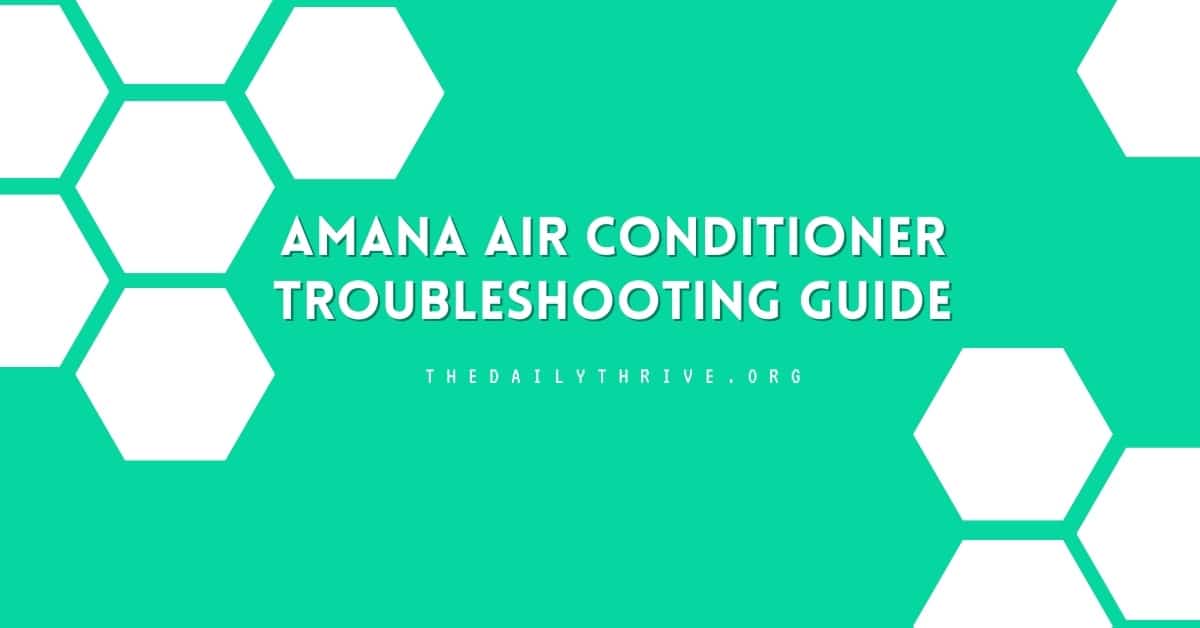As an experienced HVAC technician, I’ve come across a plethora of air conditioner issues in my time, many with the popular Amana AC units. While these units are renowned for their efficiency and durability, like all machines, they occasionally face hitches. Over the years, I’ve recognized some common Amana air conditioner problems and their solutions.
Allow me to guide you through troubleshooting these air conditioner issues, ensuring you keep cool when the temperatures soar.
Preliminary Troubleshooting Steps
Before you jump into specific Amana air conditioner issues, let’s knock out some quick fixes:
- Check the Air Filters:
Air filters trap dust, pollen, and other particulate matter to provide clean air inside your home. Over time, these particles accumulate, obstructing the airflow and making the system work harder than it needs to. This not only affects your comfort but can also hike up energy bills and even damage your system.- What to do: Locate your air filter, usually found inside the air handler or return air duct. Inspect it. If it’s darkened or visibly dirty, it’s time for a change. Washable AC filters can be cleaned with a mild detergent and then thoroughly dried. Non-washable ones should be replaced. As a rule of thumb, inspect your filters at least once a month and replace or clean them every two to three months.
- Thermostat Check:
Think of the thermostat as the brain of your Amana AC unit. Even a tiny glitch or incorrect setting can misdirect your entire system.- What to do: First, confirm it’s set to the “cool” mode. Ensure the fan setting is on “auto,” which means the fan will run only when the AC is cooling. If you’ve had recent power outages, replace the batteries, as many thermostats rely on battery power. If your thermostat is digital, the display should be lit, and if it’s not, it might be a sign that the thermostat is malfunctioning.
- Examine the Drain Pan:
The drain pan catches condensation from your AC unit. When functioning correctly, the water in the pan drains out, preventing mold growth and water damage. If it’s overflowing or not draining, you’ve got a problem.- What to do: First, switch off the AC. Next, look inside the air handler for a tray-like pan beneath the evaporator coil. If you see standing water, you need to address it. Clear out any debris or mold. If water persists, the drain might be clogged.
- Inspect the Drain Line:
The drain line channels condensation away from your Amana air conditioner. A clog can lead to backups, causing leaks, water damage, and mold.- What to do: Locate the drain line, often a PVC pipe coming from the drain pan. If you suspect a blockage, use a wet/dry shop vacuum to suck out the obstruction. As a preventive measure, occasionally pouring a mixture of bleach and water (a cup of each) can help keep the line clear.
These are the first lines of defense in Amana air conditioner troubleshooting. If problems persist after these checks, it might be time to call a professional HVAC technician.
Common Problems with Amana Air Conditioners
Below are the most common Amana air conditioner problems and how to fix:
1. Amana AC Not Turning On
The issue is simple: Your Amana air conditioning unit isn’t powering up or showing signs of life. Regardless of the settings or temperature, the AC remains non-responsive.
Likely causes and how to fixes:
- Power Switch on Outdoor Unit
The power switch, typically located on or near the outdoor unit (compressor), may have been accidentally turned off or could be malfunctioning.- Fix: Locate the power switch and ensure it’s in the ON position. If you suspect the switch is defective, avoid tampering with it and seek professional assistance.
- Tripped Electrical Breaker
Overcurrent, short circuits, or power surges can trip the breaker, disconnecting power to your Amana AC.- Fix: Inspect your home’s electrical panel. Locate the breaker associated with the AC and check if it’s in the OFF position. If it has tripped, reset it to ON. If the breaker keeps tripping, refrain from constantly resetting it, as there might be an underlying electrical issue that requires a technician’s attention.
- Blocked Air Filters
Dusty or dirty air filters can obstruct airflow. This can lead the AC to overwork, resulting in safety shutdowns or preventing the system from starting.- Fix: Regularly inspect the filters. Clean or replace them if they appear clogged. A general rule is to check them monthly and replace them every 2-3 months, depending on usage.
- Debris Around the Outdoor Unit
Over time, leaves, grass, and other debris can accumulate around the outdoor unit, restricting airflow and possibly causing the unit to shut down.- Fix: Clear the area around the outdoor unit. Ensure there’s at least a 2-foot clearance on all sides. Gently hose down the unit to remove accumulated dirt, but avoid high-pressure streams as they can damage the fins.
- Thermostat Issues
A malfunctioning thermostat can’t communicate the cooling command to the AC.- Fix: Ensure the thermostat is set to “cool” and “auto.” If it’s battery-operated, try changing the batteries. Check for any loose connections or signs of damage. If the thermostat display is blank or behaves erratically, it might need replacement.
What if none of the above works?
After diligently performing the above checks and fixes, if your Amana AC still refuses to start, it’s time to consult with an HVAC professional. The issue might be more intricate, such as a failed capacitor, faulty motor, or wiring issues. In such cases, professional expertise ensures safe and effective troubleshooting.
2. Amana AC Blowing Warm Air
You’ve turned on your Amana AC, expecting a gust of cool, refreshing air. Instead, you’re met with a breeze that’s warm or lukewarm, defeating the purpose of an air conditioner.
Likely causes and how to fixes:
Thermostat Settings
The most basic and often overlooked reason could be incorrect thermostat settings.
Fix: Double-check your thermostat. Ensure it’s set to “cool” and not “heat” or “fan only.” The fan setting should be on “auto” to ensure the system isn’t just blowing without cooling. If there’s any discrepancy, adjust the settings accordingly.
Power Issues with the Outdoor Unit
The outdoor compressor unit plays a pivotal role in the cooling process. If it’s not powered or not working optimally, the AC will blow warm air.
Fix: Inspect the outdoor unit. Make sure it’s powered on. Listen for any abnormal sounds or notice any unusual behaviors. If the unit is silent, it might not be getting power. Check the circuit breaker associated with the AC and ensure it hasn’t tripped.
Blocked or Dirty Air Filters

Blocked or dirty air filters can restrict airflow, causing the evaporator coils to freeze. When they thaw, the system might blow warm air.
Fix: Regularly inspect the air filters in your system. Clean or replace them if they’re dirty or clogged. A good practice is to replace them every 2-3 months.
Refrigerant Leak
A refrigerant is a substance that helps your AC cool the air. A leak or low levels of refrigerant will hinder this process.
Fix: Look for signs of a refrigerant leak. A frosted or frozen coil inside the indoor unit is a red flag. On the outdoor unit, touch the copper pipe. If it’s warmer than usual, it might indicate a refrigerant issue. Addressing refrigerant leaks is a job for professionals due to the hazardous nature of the substance. Call an HVAC technician to inspect, fix the leak, and recharge the refrigerant.
Blocked or Dirty Condenser Coils
The condenser coils in the outdoor unit release the heat extracted from indoors. If dirty, they can’t effectively release that heat, leading the system to underperform.
Fix: Visually inspect the condenser coils. If they seem dirty or clogged, turn off the unit and gently clean them using a soft brush or hose them down with water. Ensure you don’t bend the coil fins.
If, after addressing the potential causes above, your Amana AC continues to blow warm air, it’s advisable to seek the expertise of a trained HVAC technician. The root of the problem could be more complex, like compressor issues, a malfunctioning expansion valve, or other internal component failures. Their professional diagnosis and solution will ensure your AC returns to its optimal cooling function.
3. Amana AC Leaking
Your Amana air conditioning unit seems to produce more than just cool air. There’s water leaking, leading to potential damage and safety hazards. This isn’t just about cooling efficiency; it’s also about protecting your property from water damage.
Likely causes and how to fixes:
Condensation Build-up: Air conditioners naturally produce condensation during their cooling process. However, this should not result in noticeable leakage.
Fix: Ensure your AC is level. If the unit is tilted, even slightly, condensation might not be channeled correctly. Adjust the positioning if necessary.
Dirty or Clogged Air Filters: A blocked filter restricts airflow. This can cause the evaporator coil to freeze. When it thaws, you might notice excessive water.
Fix: Regularly inspect, clean, or replace the air filters. Keeping them clean not only prevents leaks but also ensures efficient cooling. Aim to check them once a month and replace them every 2-3 months or as needed.
Drain Pan Issues: The drain pan, located beneath the evaporator coil, catches condensation. If it’s damaged or misaligned, water can spill over.
Fix: Examine the drain pan for any damage like cracks or rust. Ensure it’s correctly positioned to catch the water. If the pan is damaged, you’ll need to replace it.
Blocked Drain Line: The drain line ensures the condensation from the AC is channeled away from the unit. If it’s clogged, water will back up.
Fix: Inspect the drain line for any blockages. If you spot a blockage, you can use a wet/dry vacuum to suck it out. Regularly flushing the drain line with bleach and water can also help prevent algae or mold build-up.
Refrigerant Leak: A refrigerant leak can cause the evaporator coil to freeze. As it thaws, it may result in more water than the system can handle.
Fix: While you can visually inspect for signs of freezing, fixing a refrigerant leak isn’t a DIY job. If you suspect this issue, it’s essential to call in an HVAC professional to address the leak and safely handle the refrigerant.
Faulty Condensate Pump: If your AC unit is in a basement, it likely has a condensate pump to pump the water outside. If this pump breaks, water can accumulate.
Fix: Check the condensate pump for any signs of malfunction. If it’s not working, it might need to be repaired or replaced.
Still, seeing a leak?
Water leaks can lead to bigger issues like mold growth or structural damage. If the problem persists despite your best troubleshooting efforts, it’s time to call an HVAC professional. The issue might lie deeper within the system or be indicative of a larger malfunction that requires expert intervention.
Summary
While Amana air conditioners are reliable, like all appliances, they have their moments. Regular checks can keep most issues at bay. But always remember, when in doubt, it’s best to call in an HVAC expert.






